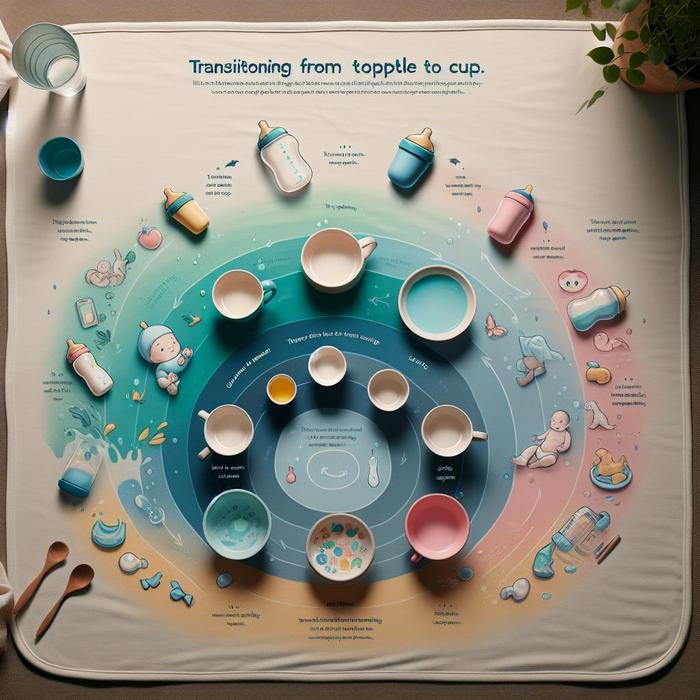Understanding the Importance of Bottle to Cup Transition
When your toddler starts showing signs of readiness, you know it’s time to make the exciting (and sometimes daunting) switch from bottle to cup. This transition isn’t only about convenience, it is also a crucial step in your child’s development. In fact, extended use of a bottle can lead to cavities and may even impair speech development. The American Dental Association recommends making the switch by your child’s first birthday, but remember, each child is unique and will make the transition at their own pace.
Identifying the Right Time to Transition
Generally, toddlers start showing signs of readiness for transitioning from bottle to cup around 9-12 months old. However, it’s crucial to remember that every child is different, and the transition should occur when they are ready. Here are some signs your child may be ready for the bottle to cup transition:
- They show interest in your cup or try to drink from it.
- They can sit independently and hold a lightweight cup with both hands.
- They communicate their thirst verbally or through gestures.
Selecting the Right Cup for Your Toddler
Once you’ve determined that your little one is ready for the transition, the next step is choosing the right cup. There are numerous options available, from sippy cups to straw cups and even regular open cups. The key is to find something that appeals to your child and fits their developmental stage.
- Sippy Cups: These are a popular choice for toddlers. They come with a spout and a valve to control the flow of liquid, which helps in managing spills. The First Years Soft Spout Trainer Cups are a good option.
- Straw Cups: These cups help in the child’s oral development and are highly recommended by pediatricians. However, they could be bit more challenging for a child to use initially.
- Open Cups: Though there are higher chances of spilling, open cups are the closest to adult cups and can be beneficial in the longer term.
Smooth Transition Tips from Bottle to Cup
Transitioning from a bottle to a cup is a big step for your child and can be facilitated by these toddler drinking tips:
- Gradual Transition: Start by introducing the cup during meal times while still giving your child their bottle at nap and bedtime. Over time, you can gradually increase the use of the cup.
- Make it Fun: Choosing cups with their favorite characters or animals can make the process exciting for your toddler.
- Be Patient: It’s entirely normal for your child to resist the change initially. Keep trying without forcing them and celebrate small wins.
Managing Spills and Messes
It’s important to be prepared that there will be spills – lots of them. But remember, they are all part of this learning process. Here are some tips for managing spills:
- Use cups with lids or a slow flow to minimize the spills.
- Consider investing in a waterproof bib or a smock.
- Keep a cleaning caddy with wipes and towels ready to handle spills quickly.
Remember, it’s all about giving your child the time they need to adjust to this new change. So, take things slow and be patient, you’ve got this!
Overcoming Challenges during the Transition
Depending on your child’s temperament, you might face a few obstacles while making the shift from a bottle to cup. It’s important to remember patience and consistency are vital during this period. A guide for parents transitioning from bottle to cup provides useful insights. Here are some strategies to tackle possible obstacles:
- Resistance: A child may resist or show no interest in the cup initially. Remain calm and maintain a positive attitude. Slowly introduce the cup during meals, when they are likely to be most receptive.
- Tantrums: A bottle-to-cup transition can cause emotions to run high. Allow your child to vent their frustration. Offer the cup independently and give them control, without pushing or forcing. Favorable outcomes usually come from perseverance.
- Mess: Expect mess and spills. Don’t get frustrated. Keep your child in an easily cleanable area during the initial transition. Use cups with lids or slow flow to manage the mess. It’s all part of the learning process.
Establishing a Routine
An effective way to smoothen the transition is to establish a routine. This gives your child a sense of security and familiarity, thus reducing resistance and tantrums. Offering the cup at the same times each day can encourage acceptance. Check this transition guide for more detailed steps.
- Start by offering the cup during meals and snacks. This familiarizes them with the new process and encourages self-feeding.
- At night, replace the bottle with a cup of water. This helps eliminate the risk of tooth decay due to milk pooling in their mouth while they sleep.
- Create a fun ritual around the new drinking method to encourage your toddler to use the cup. For instance, telling a story or singing a song about a favorite character who also drinks from a cup.
Seeking Expert Advice
If you’re struggling with the transition, it can be helpful to consult with your pediatrician or a feeding specialist. Often, they can offer personalized advice to make the transition smoother. The Evenflo feeding products website provides expert advice and a range of cup options you can choose from.
The journey from bottle to cup is not just about a change in feeding practices, but also about growth, independence, and development. As parents, your role is crucial in guiding and supporting your child through this process. This transition is a significant milestone in your child’s life. Celebrate it, embrace the mess, and most importantly, enjoy this time with your child.
